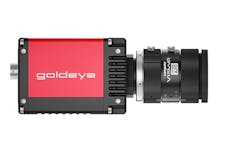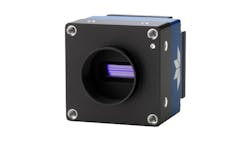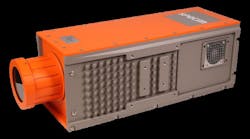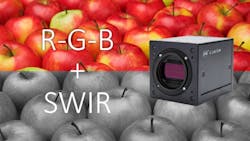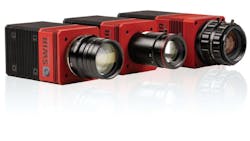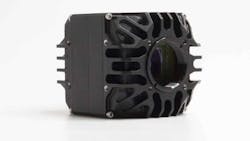SWIR Imaging Enables Many Types of Machine Vision Applications
Shortwave infrared (SWIR) imaging allows machine vision professionals to develop applications that aren’t accomplished easily using visible light.
SWIR is a band of light in the electromagnetic spectrum that is beyond human vision. Experts typically define SWIR as light in the wavelength range of 0.9-1.7 µm, but some of them classify it as between 0.7-2.5 µm, according to Edmund Optics (Barrington, NJ, USA).
For the most part, SWIR light “behaves the same as what you’ve learned about visible light,” David Dechow, founder of Machine Vision Source (Salisbury, NC, USA), explains in a 2023 Vision Systems Design Webinar on SWIR imaging. (bit.ly/45b0Q2k).
Although it generally behaves the same as visible light, SWIR light reacts to some common substances—such as water, plastic and glass—differently than visible light. This characteristic makes SWIR more useful than visible light in machine vision applications involving these substances.
For example, some SWIR wavelengths are absorbed by water, meaning that the water will appear dark in images taken by SWIR cameras. On the other hand, SWIR light is transmitted by some types of plastic, making these plastics invisible when viewed by SWIR cameras.
Using these properties, engineers can develop applications using SWIR imaging to detect “water-based content inside of completely opaque plastic containers (like milk in a solid white milk bottle),” Dechow says. The cameras also are useful for inspecting food with high water content, such as fruit, because quality issues, such as bruises or soft spots, will be visible, Dechow explains.
Adds Jens Hashagen, SWIR imaging business development manager for Allied Vision Technologies GmbH (Ahrensburg, Germany.), “SWIR imaging is gaining momentum in many applications as more and more users understand that many materials distinguish themselves by their spectral response in the SWIR range.”
Detecting Moisture
In addition to measuring the liquid level in a container, identifying moisture in clothing is another application that takes advantage of the way SWIR light reacts to water. “Detecting moisture in clothing using SWIR imaging involves capturing subtle changes in reflectance patterns, as moisture alters the reflectance of light at 1400 nm. SWIR can identify where and how much moisture is in the fabric, making it invaluable for quality control in textile manufacturing,” explains Martin H. Ettenberg, president and CEO of Princeton Infrared Technologies (Monmouth Junction, NJ, USA).
Medical Imaging
Hashagen at Allied Vision explains the role of SWIR imaging in another important application. “In the field of medical imaging, implementing short-wave infrared is particularly promising because important human body components such as water, fat and collagen show clear absorption peaks in this wavelength range. SWIR, often referred to as the NIR-II window in medical imaging, increases imaging depth and greatly reduces the self-fluorescence and photon scattering that occurs between 400-950 nm. Rather than transparent or translucent images in the visible range, SWIR provides characteristic high contrast images that facilitate pre-clinical and clinical applications,” Hashagen says.
Identifying Methane Gas
SWIR is also used to monitor pollution. For example, “SWIR technology offers numerous benefits for methane detection. SWIR is sensitive to methane gas, allowing for the detection of even trace amounts of this greenhouse gas using multiple wavelengths of light. This sensitivity is crucial for detection of sources and areas where it is prevalent,” says Ettenberg of Princeton Infrared Technologies. “SWIR is the best choice for this application because SWIR has high quantum efficiency (QE) and low read noise with room temperature operation. It allows for a smaller, lighter system that can eventually be placed on a satellite.”
Inspecting Solar Panels
“While inspection of solar cells is not new, it is an application for SWIR that continues to develop. Expectations are that as the demand and adoption of EVs grows, so will demand for electricity on a global scale,” explains Matthias Moser, CMOS sensor development leader at Teledyne DALSA (Waterloo, ON, Canada). “As electricity costs rise to meet the increased demands for electricity, solar energy in the form of solar panels and indeed solar farms will provide an alternative to higher prices and help meet in-country demand for production of electricity for charging.”
Mining Minerals
“One of the most critical application areas of SWIR technology is still the mining industry and mineral identification. This is because of the OH bonds in many essential minerals, some of which are only identifiable in the SWIR range (vs. MWIR and LWIR),” says Mathieu Marmion, PhD, lead application specialist at Specim Spectral Imaging Oy Ltd (Oulu, Finland).
SWIR imaging is used from the air to explore large areas of rock. It also is used to analyze drill cores and geological samples, Specim says on its website.
Free Space Optical Communications
Allied Vision points to a futuristic use case: free space optical communication (FSOC), a method of telecommunications that uses lasers to transmit data wirelessly through the atmosphere and space.
However, the lasers typically used in this application do not address a shortcoming of FSOC for on-earth communications. FSOC transmissions can be disturbed by such atmospheric interferences as atmospheric absorption and scattering due to rain, fog, snow or pollution. They also are prone to interference background light sources, including the sun.
Using SWIR-band lasers addresses this issue, Hashagen explains. “Lasers operating at 1550 nm are well suited for FSOC because they suffer less under atmospheric interferences enabling long range data transmissions, are eye-safe, and the availability of high-quality transmitter and detector components is high, as such components are already used by the telecommunication industry for fiber-based communications.”
SWIR-band lasers are deployed with SWIR cameras, which are used in this application as receivers.
“SWIR cameras are used in FSOC systems to adjust the adaptive optics (AO) to further enhance the signal detection and optimize the system’s performance and reliability. Key performance features are high sensitivity at 1550 nm, low-noise specifications, and support of high frame rates. Additionally, cameras without sensor glass are beneficial to increase the signal power and prevent image artifacts caused by reflections inside the glass and contamination in the anti-reflection layer of the sensor glass,” Hashagen says.
SWIR Imaging Components
To image with SWIR, engineers and technical professionals use specialized products including sensors. Because SWIR light transmits directly through silicon, SWIR sensors use different materials than visible light sensors. The most common material is indium gallium arsenide (InGaAs). Colloidal quantum dot (CQD) and cu-cu bonding are other materials used for SWIR sensors.
According to Princeton Infrared Technologies, InGaAs has a “quantum efficiency of greater than 80% between 950-1650 nm, while CQD has less than a 10% signal across most of the SWIR wavelength.”
However, Sam Wyman, global sales manager for SWIR Vision Systems (Research Triangle Park, NC, USA), says, “While the current quantum efficiency of CQD SWIR sensors may be lower than commercially available InGaAs SWIR sensors, it's important to highlight the substantial progress being achieved in enhancing the quantum efficiency of the next generation of CQD SWIR sensors.” Wyman also notes that CQD sensors generally have a broader spectral range than InGaAs sensors, allowing them to support multiple spectral ranges with a single sensor.
No matter the sensor material, experts expect the use cases for SWIR to grow as the technology continues to improve. As Marmion at Specim says, “The development of SWIR cameras in the last years has followed the common trend to make faster and more affordable cameras with more pixels that would be more suitable for industrial line systems, enabling customers to apply SWIR technology more broadly for more accurate material inspection and quality control in different fields.”
Area scan sensors are the most common type used in SWIR imaging, though some manufacturers use a line scan approach, Dechow adds.
Machine vision applications involving SWIR imaging also use other typical components such as lights, filters and lenses.
Examples of some of the commercial products available include the following:
• The Linea SWIR CMOS GigE line scan camera with an InGaAs sensor from Teledyne Dalsa is available as a 1k resolution camera with 12.5 µm pixels, or a 512-resolution camera with 25 µm pixels. Both have a maximum line rate of 40 kHz. The cameras operate in the 950-1700 nm spectrum.
• A SWIR line-scan camera that simultaneously captures RGB and SWIR image data from JAI (San Jose, CA, USA) features 4-sensor line scan technology that allows for simultaneous collection of red, green and blue image data on three separate CMOS sensors plus a fourth sensor that collects image data from the SWIR spectrum using a sensor based on InGaAs technology. The SW-4010Q-MCL camera’s InGaAs SWIR sensor has a resolution of 1024 pixels, a sensor width of 25.6 mm, and a full resolution scan rate of 39 kHz. The camera is part of JAI’s Sweep+ Series.
• The Goldeye SWIR camera series from Allied Vision integrates Sony’s SenSWIR InGaAs sensors. The cameras have a pixel size of 5 × 5 μm, single-stage sensor cooling, and a fanless design. They allow image acquisition in the 400-1700 nm range and include several image correction functions. They are compliant with either Camera Link or GigE Vision interfaces. The Goldeye G-030, with the IMX991 sensor, has a frame rate of 234 fps at a resolution of 656 x 520 pixels, while the Goldeye G-130, with the IMX990 sensor, has a resolution of 1280 x 1024 pixels with a maximum frame rate of 94 fps.
• The Acuros SWIR cameras from SWIR Vision Systems have a CQD-on-CMOS sensor and provide imaging in the visible, near infrared (NIR) and SWIR spectrums. With either a USB 3.0 or GigE Vision interface, the cameras are available in three resolutions: 2.1 MP, 1920 x 1080 format sensor; 1.2 MP, 1280 x 1024 format sensor; and VGA, 640 x 512 format sensor.
• The SenS 1280 HD SWIR camera-Smart Version from New Imaging Technologies (Verrières le Buisson, France) has a resolution of 1280 X 1024 pixels, frame rate of 60Hz full frame and QE of over 80%. It has image processing capabilities that eliminate manual adjustments, such as automatic gain control, which enables optimal brightness and contrast, and automatic integration time, which adjusts the exposure time to match the target brightness.
• The Specim SWIR camera operates in the 1000-2500 nm range, has 384 spatial pixels, and achieves up to 400 fps using a Camera Link connection. It also has a rugged weather-proof IP54 casing.
About the Author
Linda Wilson
Editor in Chief
Linda Wilson joined the team at Vision Systems Design in 2022. She has more than 25 years of experience in B2B publishing and has written for numerous publications, including Modern Healthcare, InformationWeek, Computerworld, Health Data Management, and many others. Before joining VSD, she was the senior editor at Medical Laboratory Observer, a sister publication to VSD.

